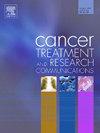靶向脂质代谢克服乳腺癌他莫昔芬耐药:评估槲皮素的协同治疗潜力
IF 2.4
Q3 Medicine
引用次数: 0
摘要
乳腺癌仍然是全球妇女中最常见的恶性肿瘤,激素受体阳性亚型占大多数病例。尽管在治疗方面取得了重大进展,但对它莫昔芬(雌激素受体阳性(ER+)乳腺癌的基础疗法)的耐药性构成了一个重大挑战,影响了高达50%的患者。越来越多的证据表明,脂质代谢失调在乳腺癌的进展和治疗抵抗中起着关键作用。本系统综述旨在探讨脂质代谢与他莫昔芬耐药之间的复杂关系,特别关注他莫昔芬与脂质代谢调节剂(如槲皮素)联合使用的潜在治疗协同作用。我们系统地检索PubMed、Scopus、Web of Science和Cochrane图书馆2000年至2023年间发表的研究,研究脂质代谢途径在乳腺癌中的作用以及槲皮素对增强他莫昔芬疗效的影响。研究结果表明,针对脂质代谢的关键酶,包括脂肪酸合成酶(FASN)和乙酰辅酶a羧化酶(ACC),可能会损害癌细胞的生存机制,并使肿瘤对他莫昔芬敏感。他莫昔芬和槲皮素联合使用比单独使用更有效地促进细胞凋亡和减少细胞增殖。本综述强调了他莫昔芬联合槲皮素作为克服他莫昔芬耐药的治疗策略的潜力,为进一步研究这种联合治疗的临床试验提供了依据。本文章由计算机程序翻译,如有差异,请以英文原文为准。
Targeting lipid metabolism to overcome tamoxifen resistance in breast cancer: Evaluating the synergistic therapeutic potential of quercetin
Breast cancer remains the most prevalent malignancy among women globally, with hormone receptor-positive subtypes representing the majority of cases. Despite significant advances in treatment, resistance to Tamoxifen, a cornerstone therapy for estrogen receptor-positive (ER+) breast cancer, poses a critical challenge, affecting up to 50 % of patients. Emerging evidence suggests that dysregulated lipid metabolism plays a pivotal role in breast cancer progression and therapy resistance. This systematic review aims to explore the intricate relationship between lipid metabolism and Tamoxifen resistance, with a particular focus on the potential therapeutic synergy of combining Tamoxifen with lipid metabolism modulators, such as Quercetin. We systematically searched PubMed, Scopus, Web of Science, and the Cochrane Library for studies published between 2000 and 2023, examining the role of lipid metabolic pathways in breast cancer and the impact of Quercetin on enhancing Tamoxifen efficacy. The findings suggest that targeting key enzymes involved in lipid metabolism, including fatty acid synthase (FASN) and acetyl-CoA carboxylase (ACC), may impair cancer cell survival mechanisms and sensitize tumors to Tamoxifen. The combination of Tamoxifen and Quercetin appears to exhibit synergistic effects, enhancing apoptosis and reducing cell proliferation more effectively than either agent alone. This review highlights the potential of combining Tamoxifen with Quercetin as a therapeutic strategy to overcome Tamoxifen resistance, providing a rationale for further clinical trials to investigate this combination therapy.
求助全文
通过发布文献求助,成功后即可免费获取论文全文。
去求助
来源期刊

Cancer treatment and research communications
Medicine-Oncology
CiteScore
4.30
自引率
0.00%
发文量
148
审稿时长
56 days
期刊介绍:
Cancer Treatment and Research Communications is an international peer-reviewed publication dedicated to providing comprehensive basic, translational, and clinical oncology research. The journal is devoted to articles on detection, diagnosis, prevention, policy, and treatment of cancer and provides a global forum for the nurturing and development of future generations of oncology scientists. Cancer Treatment and Research Communications publishes comprehensive reviews and original studies describing various aspects of basic through clinical research of all tumor types. The journal also accepts clinical studies in oncology, with an emphasis on prospective early phase clinical trials. Specific areas of interest include basic, translational, and clinical research and mechanistic approaches; cancer biology; molecular carcinogenesis; genetics and genomics; stem cell and developmental biology; immunology; molecular and cellular oncology; systems biology; drug sensitivity and resistance; gene and antisense therapy; pathology, markers, and prognostic indicators; chemoprevention strategies; multimodality therapy; cancer policy; and integration of various approaches. Our mission is to be the premier source of relevant information through promoting excellence in research and facilitating the timely translation of that science to health care and clinical practice.
 求助内容:
求助内容: 应助结果提醒方式:
应助结果提醒方式:


